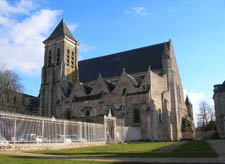Châteaudun (Eure-et-Loir, France) - Sainte-Madeleine
- Disclaimer
The dating found here is based on the work of John James, and is meant on this site to serve as a starting point. James' dating is derived from a system that uses his interpretation of the development of capitals over time as the basis for chronology, among other factors. His goal is to refine the dating to within years rather than decades. I have not fully embraced James' methodology, and will be developing this page from its current state to one which is admittedly more conservative. The relative expenditure values found in the Timeline are also based on James' work, and I believe these to be reasonably reliable. They are intended only to give a sense of the amount of work involved in each decade.
I have added the idea of the "project" as a way of separating work in buildings. In my mind, a "project" is a discrete section of work in a building that resulted from the one-time acquisition of funding. "Projects" are generally separated by at least a decade where no work was being done. It is my view that it would have been unwise to start a "project" that could not be finished and protected from the elements, and as such a "project" usually involved a wing or multiple wings of a building, from floor to roof. Rural churches, which could only secure small amounts of funding at irregular intervals, often were the result of many small projects, while the great churches, which benefitted from relatively consistent funding, may have involved only a few large projects.
I have added the idea of the "project" as a way of separating work in buildings. In my mind, a "project" is a discrete section of work in a building that resulted from the one-time acquisition of funding. "Projects" are generally separated by at least a decade where no work was being done. It is my view that it would have been unwise to start a "project" that could not be finished and protected from the elements, and as such a "project" usually involved a wing or multiple wings of a building, from floor to roof. Rural churches, which could only secure small amounts of funding at irregular intervals, often were the result of many small projects, while the great churches, which benefitted from relatively consistent funding, may have involved only a few large projects.
- Timeline with Relative Expenditure (if available, in building units)
 |
 |
 |
 |
 |
 |
 |
 |
- Project A - Earlier - Phase 1 -
East with chapels and ambulatory, now under floor
- Project B - 1080s - Phase 2 - tower base
Tower base
- Project C - 1120s - Phase 3 - nave (d)
- Project C - 1130s - Phase 4 - s portal
South portal archivaults
- Project C - 1130s - Phase 5 - s nave (a)
- Project C - 1140s - Phase 6 - n nave (a)
Dado on west and north walls of the north nave; pier bases were set out in a number of campaigns within earlier walls; five different templates in the north; south 6-7 pier bases like some in the north; S4 is rectangular over base for 8 corner shafts, and S7 the shafts are smaller than the sizes intended in the plinth and has doubled shaft bases as in the north.
- Project C - 1140s - Phase 7 - n nave (a)
Aisle pier capitals and start of vaults; distortions in the arcade arches and variations in vault profiles indicate many changes of design.
- Project C - 1140s - Phase 8 - n nave (aw)
Aisle window capitals and arches
- Project D - 1180s - Phase 9 - s nave walls
South nave aisle S5
- Project D - 1190s - Phase 10 - crypt
Crypt ambulatory, no caps but large windows that look like Chartres crypt
- Project D - 1200s - Phase 11 - n nave (t.c)
North nave triforium and clerestory
- Project E - 1220s - Phase 12 - s3 nave pier
S3 pilier cantonne; S2 later.
- Project E - 1220s - Phase 13 - s nave (t,c)
South nave triforium and clerestory
